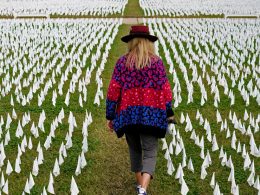A research team at Columbia University believes only 20% of COVID-19 infections are confirmed by testing — suggesting that more than 60% of North Dakotans already have been infected. If true, that means the state is approaching herd immunity.
North Dakota could be well on the way to herd immunity against the coronavirus as researchers at Columbia University believe more than 60% of residents already have been infected.
But researchers who developed the model at Columbia caution that even though vaccination efforts are well underway, masks and social distancing precautions still will be needed through mid-summer or later.
Jeffrey Shaman, an epidemiologist at Columbia, believes more than 105 million Americans already could have been infected, well above the 25 million that have been reported, including more than 60% in North Dakota.
Shaman’s team has been studying the true incidence of infection, starting with the outbreak in China, and has estimated that only 20% of cases are confirmed through testing. The vast majority are missed because people have no symptoms, only mild symptoms or never bother to get tested, he said.
“It seems the majority of cases are undocumented,” Shaman said.
In North Dakota, 12.5% of the population tested positive, meaning the number of people who actually have been infected is more like 62.5%, Shaman told Forum News Service.
“Per capita, your case numbers are the highest of any state in the country,” with South Dakota lagging slightly behind, he said.
“It looks like a classic outbreak,” Shaman added. “So given that, basically it’s an experiment in getting to herd immunity through natural infection.”
If the pandemic dynamics in North Dakota continue on this path, the state should end up with 65% to 70% of the population infected.
If people are reinfected, the question becomes whether they develop mild or severe cases requiring hospitalization. If the virus produces mild second cases, the outbreak should gradually diminish, Shaman said.
North Dakota could see another 10% or 15% of the population get infected, he said. “But you don’t want that because that’s a lot of people getting sick.”
In North Dakota, vaccines still will help — and still should be made available — but with so many already infected the pandemic should slowly dissipate, Shaman said.
“In some ways, the vaccine is much too late for you guys, but it should be distributed there,” he said.
Because the infected population in North Dakota is so large, it should be one of the first areas in the country to emerge from the pandemic, Shaman added.
The consensus among medical experts holds that “herd immunity” is established when 70% to 75% of a population has been infected and recovered or has been vaccinated, a point at which a contagion will gradually disappear.
RELATED: Read more recent coronavirus news from the region
Health providers and public health officials urge people to continue taking precautions, including wearing masks and keeping safe distances, even as vaccines are being distributed.
So far, 96,874 North Dakota residents have tested positive for the virus, or about 12.6% of the population, according to the state Department of Health.
Dr. Doug Griffin, vice president and chief medical officer of Sanford Health in Fargo, said the Columbia estimate that 60% of North Dakotans have had COVID-19 strikes him as being on the “higher end.”
If accurate, he said, “Sixty percent does get us closer to herd immunity.”
Dr. Rich Vetter, chief medical officer of Essentia Health in Fargo, said a crucial factor will be how long a person who has contracted the virus remains immune.
“The challenge is we don’t know if that immunity lasts a long time or not,” he said. So far, research indicates immunity should last at least three months. More should be known within the next couple of months, Vetter said.
“I think that’s really the question mark — how long does that immunity last?” he said.
Shaman agreed that the duration of immunity among those already infected is an important unknown.
Models used by Sanford and Essentia to predict the path of the pandemic do not show any expected spikes within the next few weeks. However, Shaman said, models can’t predict what might happen with the more contagious virus variants now circulating.
Beginning in February, Sanford’s laboratory will have the ability to do the genetic sequencing needed to identify coronavirus variants, Griffin said.
The North Dakota Department of Health is testing for new variants, which so far haven’t been detected.
“Our goal is to encourage people to get tested so we can identify, trace and isolate positive individuals as early as possible,” spokeswoman Nicole Peske said. “This is also why it’s important for people to continue COVID prevention measures like washing hands, wearing a mask, physical distancing, staying home when sick and isolating and quarantining when needed.”











